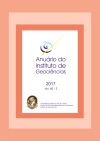Wind Pattern Change Along a Period of Coastal Occurrence Variation of a Stinging Medusa on a SW Atlantic Beach
DOI:
https://doi.org/10.11137/2017_3_303_315Keywords:
Offshore winds, Sea Surface Temperature (SST) anomalies, Coastal ecosystem, Olindias sambaquiensis, Southwestern Atlantic OceanAbstract
Monte Hermoso (SW Atlantic, Argentina) is a coastal ecosystem highly modulated by wind forcing. Ofshore winds have historically played a leading role in the tourist influx as they are associated with the occurrence of the endemic stinging medusa Olindias sambaquiensis. This species is closely related to warm summers but it could be favored by low temperatures in previous winters. Since summer 2013, a change in the wind pattern was locally perceived coincidently with the absence of the medusa in coastal waters. This work aimed at analyzing if wind pattern and sea surface temperature (SST) showed a measurable change along 2008-2015 and evaluating if this change can be associated to the observed variations in the occurrence pattern of O. sambaquiensis. Winds and SST data were analyzed in periods of high (2008-2012) and low (2013-2015) medusae occurrence, based on media and own observations. A significant change in the wind pattern in Monte Hermoso was detected. Wind speed decreased from 6.3 m s-1 in 2008 to 2.4 m s-1 in 2015 and calms and light winds increased by more than 44.2 and 7.5 %, respectively. This change implied an impediment of coastal upwelling, which is the physical process by which medusae reach the coast, and is associated with persistent (10 h or more) WNW to ENE winds blowing at ≥ 3.3 m s-1. Accordingly, in summer 2008 (period of high medusae occurrence), 45 coastal upwelling-days were detected in contrast to only 8 days in summer 2015 (period of absence of medusae). Also, positive SST anomalies were found over the 8-yr period, suggesting an increasing trend of 0.4 °C. Higher temperatures than normal during recent winters probably afect negatively the polyp reproduction. Our results demonstrate an environmental change in the ecosystem of Monte Hermoso and may explain, in part, the low occurrence of O. sambaquiensis in recent summers. The knowledge of the factors that regulate the occurrence of O. sambaquiensis is fundamental for developing a coastal management plan and/or for determining the first adaptation strategies.Downloads
Download data is not yet available.
Downloads
Published
2019-07-30
How to Cite
Brendel, A. S. (2019) “Wind Pattern Change Along a Period of Coastal Occurrence Variation of a Stinging Medusa on a SW Atlantic Beach”, Anuário do Instituto de Geociências. Rio de Janeiro, BR, 40(3), pp. 303–315. doi: 10.11137/2017_3_303_315.
Issue
Section
Article
License
This journal is licensed under a Creative Commons — Attribution 4.0 International — CC BY 4.0, which permits use, distribution and reproduction in any medium, provided the original work is properly cited.















